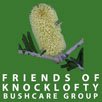Before the arrival of Europeans, Tasmanian Aborigines called the area around Hobart Nibberloone or Linghe. it was the territory of the Mouheneer band of the South East Nation. The Mouheneener people were one of several bands living on the western bank of the Derwent River. Aboriginal people would have used the reserve and surrounding hills and mountains, draped in natural vegetation and rich in plants and animals to provide their families with food, medicine and other necessities for thousands of years. Due to the many alterations to the landscape of the Knocklofty Reserve, today we can only surmise the extent of Aboriginal occupation within the reserve; however, we do know that they used rock shelters in the vicinity. |

